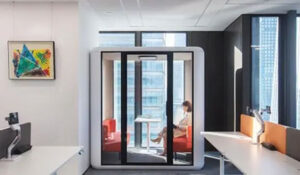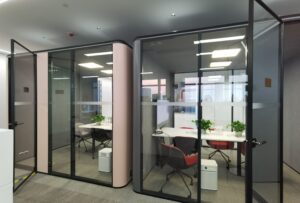Acoustic design plays a vital role in reducing noise and enhancing sound quality. You can create a peaceful environment by investing in soundproofing pods. These pods use advanced materials like double-glazed doors and walls to absorb sound effectively. For instance, the Framery Q pod reduces speech levels by 29 dB, while Inbox Booths lower outside noise by 26-30 decibels. Such features make them ideal for quiet office spaces. Understanding these principles helps you appreciate how soundproofing pods transform noisy areas into serene havens.

Acoustic Design Principles
Fundamentals of Sound and Acoustics
Understanding the basics of sound and acoustics is crucial for effective acoustic design. Sound travels in waves, which can reflect, absorb, or transmit through different materials. You can think of sound waves as ripples in a pond, spreading out and interacting with their environment.
Sound Waves and Their Behavior
Sound waves behave differently depending on the surfaces they encounter. Hard surfaces like concrete reflect sound, causing echoes and reverberation. In contrast, soft, porous materials such as foam or carpets absorb sound, reducing noise levels. This absorption is measured by the sound absorption coefficient, which indicates how much sound a material can absorb. A coefficient of 1.00 means complete absorption, while 0.01 indicates minimal absorption.
Acoustic Properties of Materials
Materials used in acoustic design have unique properties that affect sound behavior. Porous materials like fiberglass and mineral wool are excellent at absorbing sound, making them ideal for reducing echoes. On the other hand, denser materials like wood or acoustic ceiling tiles can help control sound transmission between spaces. By selecting the right materials, you can create an environment that minimizes unwanted noise and enhances sound quality.
Key Principles in Acoustic Design
Acoustic design involves applying principles that manage sound within a space. These principles focus on sound absorption, reflection, and isolation to create an optimal acoustic environment.
Sound Absorption and Reflection
Sound absorption reduces noise by soaking up sound waves, preventing them from bouncing around a room. You can achieve this by using materials like acoustic panels, which are designed to absorb sound effectively. Reflection, on the other hand, involves redirecting sound waves to control their path. By strategically placing reflective surfaces, you can enhance sound clarity and reduce unwanted noise.
Noise Isolation Techniques
Noise isolation techniques aim to prevent sound from entering or leaving a space. This involves using materials that block sound transmission, such as thick walls or double-glazed windows. By isolating noise, you can create quiet areas where people can focus without distractions. These techniques are essential in environments like offices, where noise can impact productivity and well-being.

Challenges and Solutions in Soundproofing Pod Production
Common Acoustic Challenges
Soundproofing pods face several challenges that can affect their performance. Understanding these challenges helps you appreciate the solutions that enhance pod effectiveness.
External Noise Intrusion
External noise intrusion poses a significant challenge in soundproofing pod production. You often encounter unwanted sounds from outside sources, such as traffic or neighboring offices. These noises can penetrate the pod, disrupting the quiet environment you seek. To combat this, manufacturers use materials with high sound transmission class (STC) ratings. These materials block external noise, ensuring a peaceful interior.
Internal Sound Clarity
Maintaining internal sound clarity is another challenge. Inside the pod, echoes and reverberations can muddle sound quality. You want clear communication, whether for phone calls or meetings. To achieve this, designers incorporate sound-absorbing materials like acoustic panels. These panels reduce echoes, providing a crisp and clear audio experience.
Innovative Solutions
Innovative solutions address these acoustic challenges, enhancing the functionality of soundproofing pods.
Design Innovations
Design innovations play a crucial role in overcoming acoustic challenges. Manufacturers experiment with different pod shapes and sizes to optimize soundproofing. For instance, some pods feature curved walls that minimize sound reflection. Others use modular designs, allowing you to customize the pod’s interior for specific acoustic needs. These innovations ensure that pods meet diverse requirements, from private phone booths to collaborative workspaces.
Engineering Techniques
Engineering techniques further enhance pod performance. Advanced engineering focuses on integrating multiple layers of soundproofing materials. You might find pods with double-glazed windows and thick walls that trap sound effectively. Additionally, some pods incorporate active noise cancellation technology. This technology uses microphones and speakers to counteract unwanted noise, creating a serene environment. By employing these techniques, manufacturers produce pods that excel in both noise reduction and sound clarity.

Materials and Technologies in Soundproofing
Acoustic Materials
Selecting the right acoustic materials is crucial for effective soundproofing. These materials help control noise levels and improve sound quality in various environments.
Types of Soundproofing Materials
You have several options when it comes to soundproofing materials. Acoustic Panels and Acoustic Ceiling Tiles are popular choices. They absorb sound waves, reducing echoes and reverberation. These materials are often used on walls, ceilings, and floors. You might also consider Soundproof Plasterboard. This material is effective at reducing airborne noise. It can be installed directly onto surfaces or used as part of a stand-alone system. Advanced versions offer even better soundproofing capabilities.
Material Selection Criteria
When choosing soundproofing materials, consider the specific needs of your space. The architectural acoustics of the room and the type of noise control desired play a significant role. For instance, in an office setting, you might prioritize materials that enhance speech clarity. In contrast, a music studio may require materials that prevent sound leakage. Evaluate the sound absorption coefficient of each material. This measurement indicates how much sound a material can absorb. A higher coefficient means better sound absorption. By selecting the right materials, you can create an environment that meets your acoustic design goals.
Advanced Technologies
Incorporating advanced technologies into soundproofing enhances the effectiveness of acoustic solutions. These technologies offer innovative ways to manage noise and improve sound quality.
Active Noise Cancellation
Active Noise Cancellation (ANC) technology actively reduces unwanted sound. It uses microphones to detect incoming noise and speakers to emit sound waves that cancel it out. This technology is particularly useful in environments with constant background noise. You might find ANC in soundproofing pods, where it creates a serene atmosphere by counteracting external sounds. By integrating ANC, you can achieve a higher level of noise reduction than with passive materials alone.
Smart Acoustic Systems
Smart Acoustic Systems represent the future of soundproofing. These systems use sensors and algorithms to adapt to changing acoustic conditions. For example, they can adjust the level of sound absorption based on the number of people in a room. This adaptability ensures optimal sound quality at all times. You might also encounter systems that integrate with smart home or office technologies. These systems allow you to control acoustic settings remotely, providing convenience and flexibility. By embracing smart acoustic systems, you can enhance the functionality and efficiency of your soundproofing solutions.
Practical Applications and Future Trends
Current Uses of Soundproofing Pods
Office Environments
In modern office environments, soundproofing pods have become essential. You often find these pods in open office landscapes where noise distractions can hinder productivity. By providing quiet, comfortable, and private spaces, these pods allow you to focus on tasks without interruptions. They offer a perfect solution for privacy and sound isolation, promoting productivity and reducing stress levels. Whether you need a space for confidential meetings or a quiet area to concentrate, soundproofing pods meet these needs effectively.
Public Spaces
Soundproofing pods also serve valuable purposes in public spaces. You might encounter them in libraries, airports, or shopping malls. In these settings, they offer a refuge from the bustling environment, allowing you to make phone calls or work on tasks in peace. These pods enhance the functionality of public areas by providing dedicated private spaces free from distractions. Their versatility makes them an attractive option for various public settings where noise control is crucial.
Emerging Trends in Acoustic Design
Sustainable Materials
Sustainability has become a significant trend in acoustic design. You see a growing emphasis on using eco-friendly materials in soundproofing pods. Manufacturers now prioritize materials that have minimal environmental impact. For instance, recycled materials or those sourced from sustainable resources are gaining popularity. By choosing sustainable materials, you contribute to environmental conservation while enjoying effective soundproofing solutions.
Integration with Smart Technologies
The integration of smart technologies represents another exciting trend in acoustic design. You can now find soundproofing pods equipped with advanced features like smart lighting and climate control. These technologies enhance user experience by allowing you to customize the pod’s environment according to your preferences. Additionally, some pods incorporate smart acoustic systems that adapt to changing noise levels, ensuring optimal sound quality at all times. This integration of technology not only improves functionality but also aligns with the modern demand for intelligent solutions.
Acoustic design significantly enhances soundproofing pods, transforming noisy environments into serene spaces. By integrating innovative materials and technologies, you can achieve superior noise control and sound quality. These advancements not only improve productivity but also foster well-being in various settings. Applying acoustic design principles across industries ensures optimal auditory experiences and functional spaces. Whether in offices, healthcare, or public areas, prioritizing acoustics creates environments that support effective communication and comfort. Embrace these principles to elevate the quality of your surroundings and enhance overall satisfaction.
